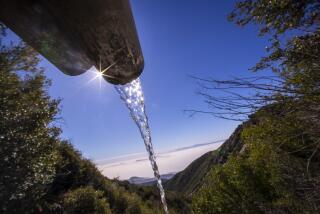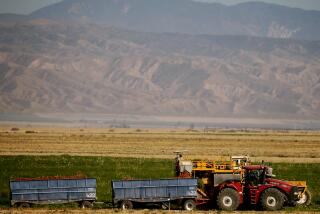U.S. Water Curb May Leave San Antonio High and Dry : Environment: A federal judge says city, ranchers can’t deplete aquifer relied on by four endangered species.
SAN ANTONIO — The farmers are angry. The ranchers are furious.
The City of San Antonio is in a dither, predicting that it could lose thousands of jobs, and warning that its citizens might be able to bathe only twice a week.
The environmentalists are victorious, with the preservation of the endangered fountain darter and the Texas blind salamander all but assured.
There is dark talk of a conspiracy, a “Chinatown” plot with a Texas twang.
All in the name of water.
The furor has been raging since a federal judge in Midland, Tex., ruled Monday that, to protect four species of endangered plants and animals, the flow of underground water to two Texas springs must be assured at all times, even in droughts. That raises the prospect that San Antonio could lose more than half of its water supply.
Though the two springs are miles from the city, they are fed by the giant Edwards Aquifer, the only source of drinking water for San Antonio and, until now, a seemingly inexhaustible and free way to irrigate farms to the west.
In his ruling, U.S. District Judge Lucius Bunton said that in times of drought, San Antonio might have to cut the amount of ground water it pumps from the aquifer by as much as 60%.
“Think about a world where you are only allowed to take a bath twice a week,” said Mayor Nelson Wolff at a news conference Wednesday. “Think about a world where you have to get a judge’s permission to irrigate your crops.”
In an earlier interview, the mayor warned that the ruling could cause great feeling against the Endangered Species Act, which has been under fire because of the spotted owl controversy in the Pacific Northwest.
“This is 10 times more important,” he said.
This story has a long history, stretching back to the 18th Century when settlers discovered they could find water by poking a hole almost anywhere over the aquifer, a 176-mile-long underground lake that spans five counties and is the major source of water for the Guadalupe River, which flows to the Gulf of Mexico.
Pumping water from the aquifer, however, has only become a source of contention in the last generation, as San Antonio grew rapidly to become the nation’s ninth-largest city. Farmers and ranchers of the region have always contended it is their absolute right to pump as much water from the aquifer as they wish. That thinking was taken to the extreme two years ago by a man who began pulling up the equivalent of a quarter of all San Antonio’s water supply for a catfish farm. He is now under a court order not to pump.
Bunton’s ruling was made in a suit filed jointly by the Guadalupe-Blanco River Authority and the Sierra Club in May, 1991. The two invoked the Endangered Species Act in protection of four items--the salamander; Texas wild rice; and two tiny fish, the fountain darter and the San Marcos gambusia--as a way of curtailing pumping from the aquifer and thus keeping the Comal and San Marcos springs flowing. Both are growing tourist attractions.
Last year, the Texas Water Commission tried to extend its jurisdiction to the Edwards Aquifer by claiming that the aquifer was an underground river. But an Austin judge overruled the commission, ruling that it was not a river and thus not under the commission’s purview.
With the Austin ruling, water became another area in Texas that could come under federal control. In the past, federal judges have taken over administration of the prison and health care systems here. The state is also in danger of having the education system taken away from it by federal authorities if major changes are not put into effect by the end of the school year.
Bunton’s ruling Monday brought a number of reactions.
John W. Jones, president of the Texas and Southwestern Cattle Raisers Assn., complained that the decision “puts the protection of Texas bugs before Texas babies.”
He also called on Congress to amend the Endangered Species Act this year.
“I would hope this decision makes our people stand up and fight for the protection of human rights,” he said. “The strict judicial interpretation of this law is playing havoc with people, land use and land value in Texas.”
Ken Kramer, the Texas state director of the Sierra Club, said San Antonio and the agricultural interests should knock off the bluster and get on with trying to encourage the state Legislature to pass water use legislation, as specified in Bunton’s opinion.
“People are mischaracterizing this as critters vs. people,” Kramer said. “The city of San Antonio is going around making noises like this is the Alamo, that they’re going to fight to the end. Now is not the time to continue litigation.”
Though he said that city officials would work with the Legislature to write water use laws acceptable to everyone, Mayor Wolff insisted that Bunton’s ruling would be appealed. He said derisively, “It does telegraph to every city in the nation that this act can be used to hurt their water supply.”
Perhaps the most acidic charge came from Cliff Morton, the chairman of the San Antonio Water System. He said he believed the Guadalupe-Blanco River Authority had devised a scheme in which it would use the increased spring flow to fill a reservoir, then sell to San Antonio water it would normally have gotten by pumping from the aquifer.
“That’s what this is all about,” he said. “It’s not about fountain darters.”
More to Read
Sign up for Essential California
The most important California stories and recommendations in your inbox every morning.
You may occasionally receive promotional content from the Los Angeles Times.










